HIST 1006 - George Copway's 'Ojibway Nation': History and Culture
VerifiedAdded on 2023/06/03
|6
|1419
|361
Essay
AI Summary
This essay provides an overview of the Ojibway Nation based on George Copway's "The Traditional History and Characteristic Sketches of the Ojibway Nation." It discusses the themes of indigenous life, migration patterns, and cultural practices of the Ojibwe people, highlighting their generosity, honor, and reciprocal relationships. The essay also explores their interactions with other tribes like the Dakota and European Americans, focusing on trade relations and agricultural practices like cultivating wild rice. Copway's depiction of Ojibwe society, including their clan system (doodem) and theological beliefs, reveals a people who were clever, valiant, and skillful in navigating their world, according to the author. The essay concludes that the Ojibwe were clever and courageous in living a tough life in the western regions of Dakota across the Mississippi river.
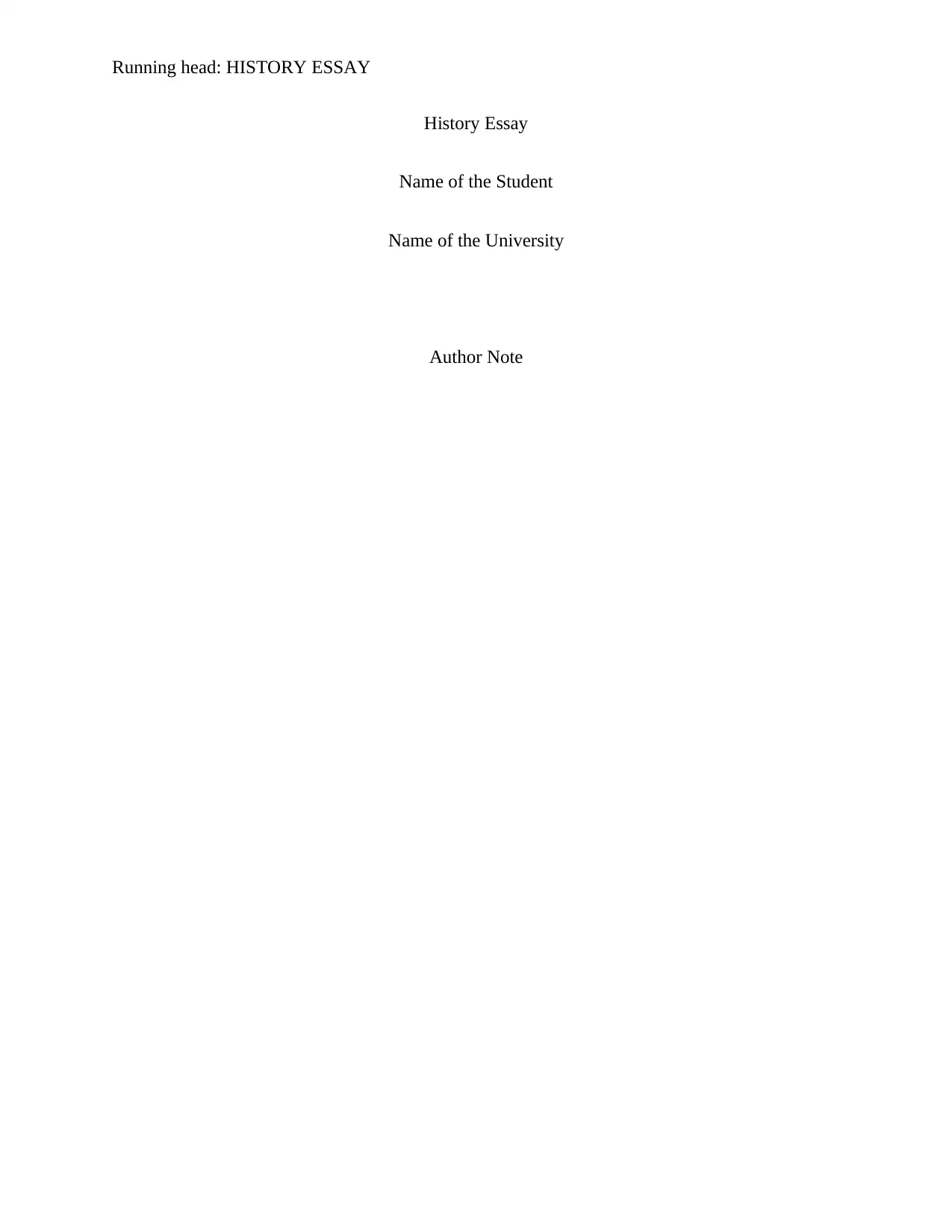
Running head: HISTORY ESSAY
History Essay
Name of the Student
Name of the University
Author Note
History Essay
Name of the Student
Name of the University
Author Note
Secure Best Marks with AI Grader
Need help grading? Try our AI Grader for instant feedback on your assignments.
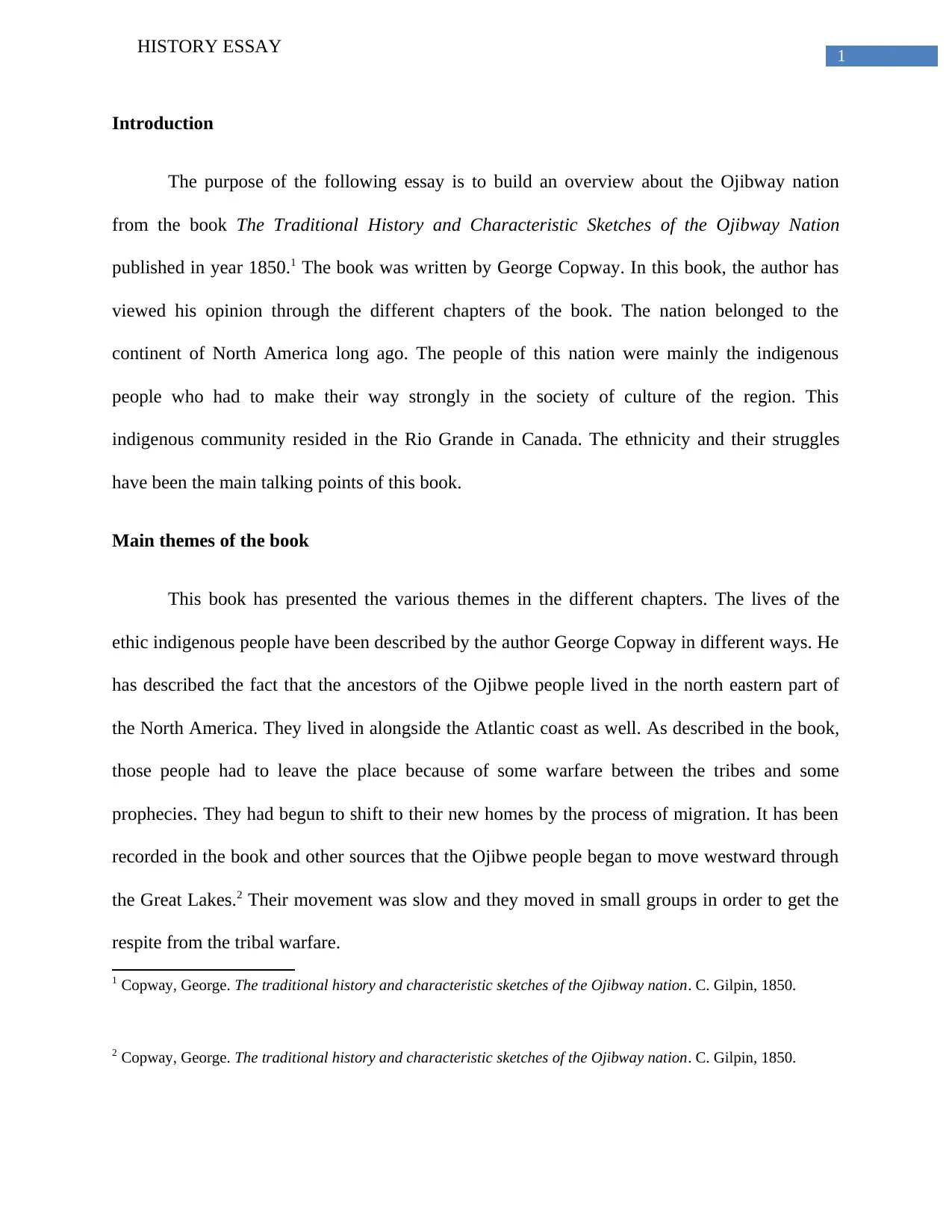
1
HISTORY ESSAY
Introduction
The purpose of the following essay is to build an overview about the Ojibway nation
from the book The Traditional History and Characteristic Sketches of the Ojibway Nation
published in year 1850.1 The book was written by George Copway. In this book, the author has
viewed his opinion through the different chapters of the book. The nation belonged to the
continent of North America long ago. The people of this nation were mainly the indigenous
people who had to make their way strongly in the society of culture of the region. This
indigenous community resided in the Rio Grande in Canada. The ethnicity and their struggles
have been the main talking points of this book.
Main themes of the book
This book has presented the various themes in the different chapters. The lives of the
ethic indigenous people have been described by the author George Copway in different ways. He
has described the fact that the ancestors of the Ojibwe people lived in the north eastern part of
the North America. They lived in alongside the Atlantic coast as well. As described in the book,
those people had to leave the place because of some warfare between the tribes and some
prophecies. They had begun to shift to their new homes by the process of migration. It has been
recorded in the book and other sources that the Ojibwe people began to move westward through
the Great Lakes.2 Their movement was slow and they moved in small groups in order to get the
respite from the tribal warfare.
1 Copway, George. The traditional history and characteristic sketches of the Ojibway nation. C. Gilpin, 1850.
2 Copway, George. The traditional history and characteristic sketches of the Ojibway nation. C. Gilpin, 1850.
HISTORY ESSAY
Introduction
The purpose of the following essay is to build an overview about the Ojibway nation
from the book The Traditional History and Characteristic Sketches of the Ojibway Nation
published in year 1850.1 The book was written by George Copway. In this book, the author has
viewed his opinion through the different chapters of the book. The nation belonged to the
continent of North America long ago. The people of this nation were mainly the indigenous
people who had to make their way strongly in the society of culture of the region. This
indigenous community resided in the Rio Grande in Canada. The ethnicity and their struggles
have been the main talking points of this book.
Main themes of the book
This book has presented the various themes in the different chapters. The lives of the
ethic indigenous people have been described by the author George Copway in different ways. He
has described the fact that the ancestors of the Ojibwe people lived in the north eastern part of
the North America. They lived in alongside the Atlantic coast as well. As described in the book,
those people had to leave the place because of some warfare between the tribes and some
prophecies. They had begun to shift to their new homes by the process of migration. It has been
recorded in the book and other sources that the Ojibwe people began to move westward through
the Great Lakes.2 Their movement was slow and they moved in small groups in order to get the
respite from the tribal warfare.
1 Copway, George. The traditional history and characteristic sketches of the Ojibway nation. C. Gilpin, 1850.
2 Copway, George. The traditional history and characteristic sketches of the Ojibway nation. C. Gilpin, 1850.
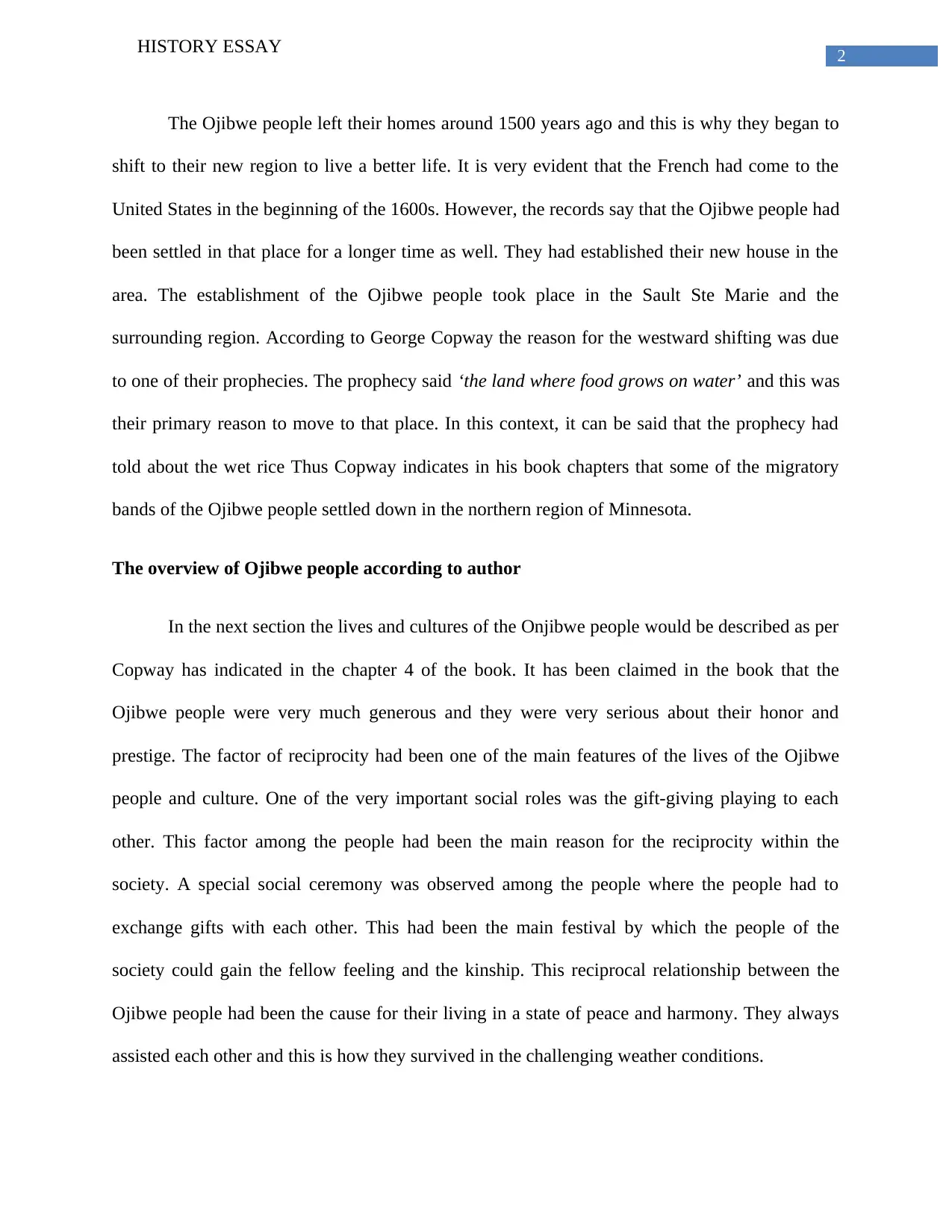
2
HISTORY ESSAY
The Ojibwe people left their homes around 1500 years ago and this is why they began to
shift to their new region to live a better life. It is very evident that the French had come to the
United States in the beginning of the 1600s. However, the records say that the Ojibwe people had
been settled in that place for a longer time as well. They had established their new house in the
area. The establishment of the Ojibwe people took place in the Sault Ste Marie and the
surrounding region. According to George Copway the reason for the westward shifting was due
to one of their prophecies. The prophecy said ‘the land where food grows on water’ and this was
their primary reason to move to that place. In this context, it can be said that the prophecy had
told about the wet rice Thus Copway indicates in his book chapters that some of the migratory
bands of the Ojibwe people settled down in the northern region of Minnesota.
The overview of Ojibwe people according to author
In the next section the lives and cultures of the Onjibwe people would be described as per
Copway has indicated in the chapter 4 of the book. It has been claimed in the book that the
Ojibwe people were very much generous and they were very serious about their honor and
prestige. The factor of reciprocity had been one of the main features of the lives of the Ojibwe
people and culture. One of the very important social roles was the gift-giving playing to each
other. This factor among the people had been the main reason for the reciprocity within the
society. A special social ceremony was observed among the people where the people had to
exchange gifts with each other. This had been the main festival by which the people of the
society could gain the fellow feeling and the kinship. This reciprocal relationship between the
Ojibwe people had been the cause for their living in a state of peace and harmony. They always
assisted each other and this is how they survived in the challenging weather conditions.
HISTORY ESSAY
The Ojibwe people left their homes around 1500 years ago and this is why they began to
shift to their new region to live a better life. It is very evident that the French had come to the
United States in the beginning of the 1600s. However, the records say that the Ojibwe people had
been settled in that place for a longer time as well. They had established their new house in the
area. The establishment of the Ojibwe people took place in the Sault Ste Marie and the
surrounding region. According to George Copway the reason for the westward shifting was due
to one of their prophecies. The prophecy said ‘the land where food grows on water’ and this was
their primary reason to move to that place. In this context, it can be said that the prophecy had
told about the wet rice Thus Copway indicates in his book chapters that some of the migratory
bands of the Ojibwe people settled down in the northern region of Minnesota.
The overview of Ojibwe people according to author
In the next section the lives and cultures of the Onjibwe people would be described as per
Copway has indicated in the chapter 4 of the book. It has been claimed in the book that the
Ojibwe people were very much generous and they were very serious about their honor and
prestige. The factor of reciprocity had been one of the main features of the lives of the Ojibwe
people and culture. One of the very important social roles was the gift-giving playing to each
other. This factor among the people had been the main reason for the reciprocity within the
society. A special social ceremony was observed among the people where the people had to
exchange gifts with each other. This had been the main festival by which the people of the
society could gain the fellow feeling and the kinship. This reciprocal relationship between the
Ojibwe people had been the cause for their living in a state of peace and harmony. They always
assisted each other and this is how they survived in the challenging weather conditions.
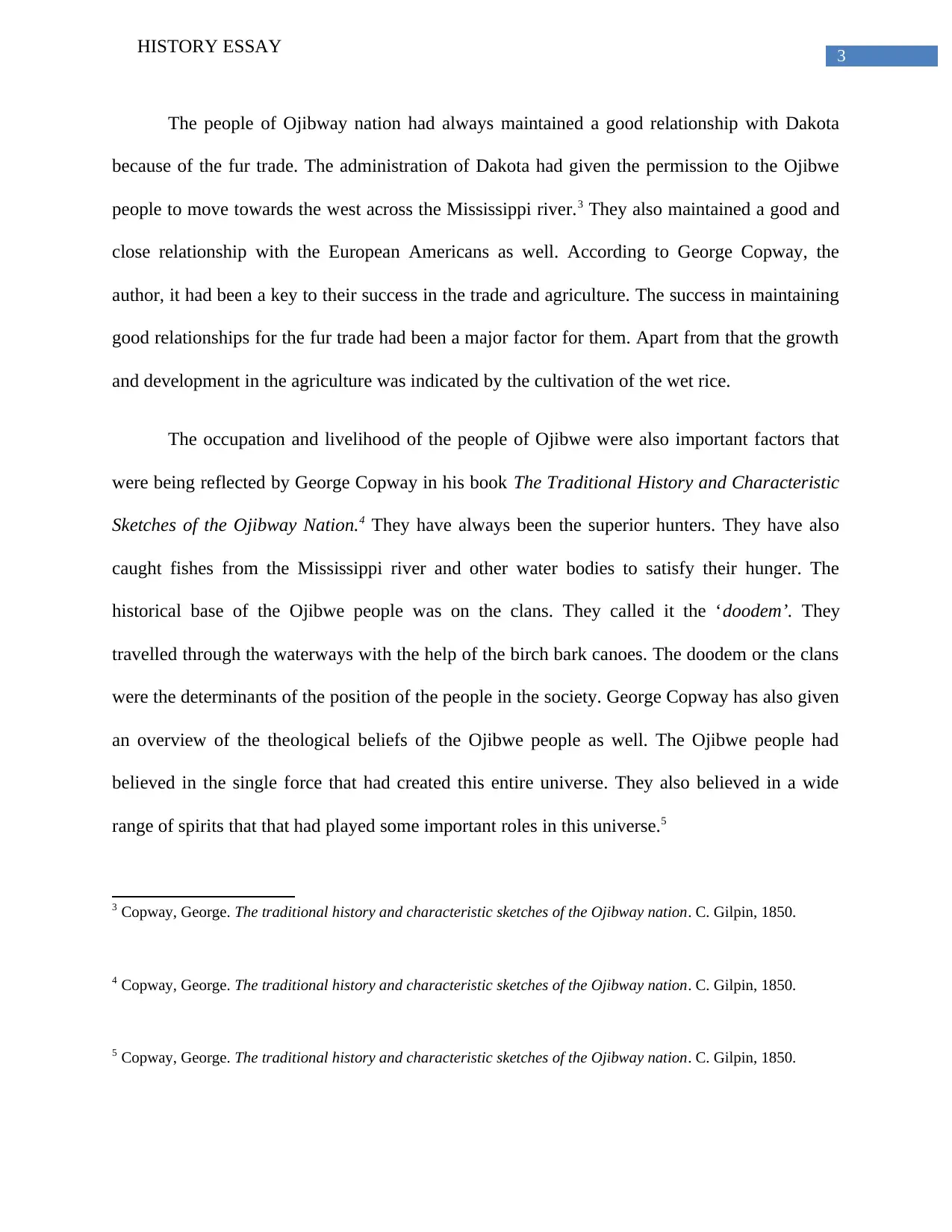
3
HISTORY ESSAY
The people of Ojibway nation had always maintained a good relationship with Dakota
because of the fur trade. The administration of Dakota had given the permission to the Ojibwe
people to move towards the west across the Mississippi river.3 They also maintained a good and
close relationship with the European Americans as well. According to George Copway, the
author, it had been a key to their success in the trade and agriculture. The success in maintaining
good relationships for the fur trade had been a major factor for them. Apart from that the growth
and development in the agriculture was indicated by the cultivation of the wet rice.
The occupation and livelihood of the people of Ojibwe were also important factors that
were being reflected by George Copway in his book The Traditional History and Characteristic
Sketches of the Ojibway Nation.4 They have always been the superior hunters. They have also
caught fishes from the Mississippi river and other water bodies to satisfy their hunger. The
historical base of the Ojibwe people was on the clans. They called it the ‘doodem’. They
travelled through the waterways with the help of the birch bark canoes. The doodem or the clans
were the determinants of the position of the people in the society. George Copway has also given
an overview of the theological beliefs of the Ojibwe people as well. The Ojibwe people had
believed in the single force that had created this entire universe. They also believed in a wide
range of spirits that that had played some important roles in this universe.5
3 Copway, George. The traditional history and characteristic sketches of the Ojibway nation. C. Gilpin, 1850.
4 Copway, George. The traditional history and characteristic sketches of the Ojibway nation. C. Gilpin, 1850.
5 Copway, George. The traditional history and characteristic sketches of the Ojibway nation. C. Gilpin, 1850.
HISTORY ESSAY
The people of Ojibway nation had always maintained a good relationship with Dakota
because of the fur trade. The administration of Dakota had given the permission to the Ojibwe
people to move towards the west across the Mississippi river.3 They also maintained a good and
close relationship with the European Americans as well. According to George Copway, the
author, it had been a key to their success in the trade and agriculture. The success in maintaining
good relationships for the fur trade had been a major factor for them. Apart from that the growth
and development in the agriculture was indicated by the cultivation of the wet rice.
The occupation and livelihood of the people of Ojibwe were also important factors that
were being reflected by George Copway in his book The Traditional History and Characteristic
Sketches of the Ojibway Nation.4 They have always been the superior hunters. They have also
caught fishes from the Mississippi river and other water bodies to satisfy their hunger. The
historical base of the Ojibwe people was on the clans. They called it the ‘doodem’. They
travelled through the waterways with the help of the birch bark canoes. The doodem or the clans
were the determinants of the position of the people in the society. George Copway has also given
an overview of the theological beliefs of the Ojibwe people as well. The Ojibwe people had
believed in the single force that had created this entire universe. They also believed in a wide
range of spirits that that had played some important roles in this universe.5
3 Copway, George. The traditional history and characteristic sketches of the Ojibway nation. C. Gilpin, 1850.
4 Copway, George. The traditional history and characteristic sketches of the Ojibway nation. C. Gilpin, 1850.
5 Copway, George. The traditional history and characteristic sketches of the Ojibway nation. C. Gilpin, 1850.
Secure Best Marks with AI Grader
Need help grading? Try our AI Grader for instant feedback on your assignments.
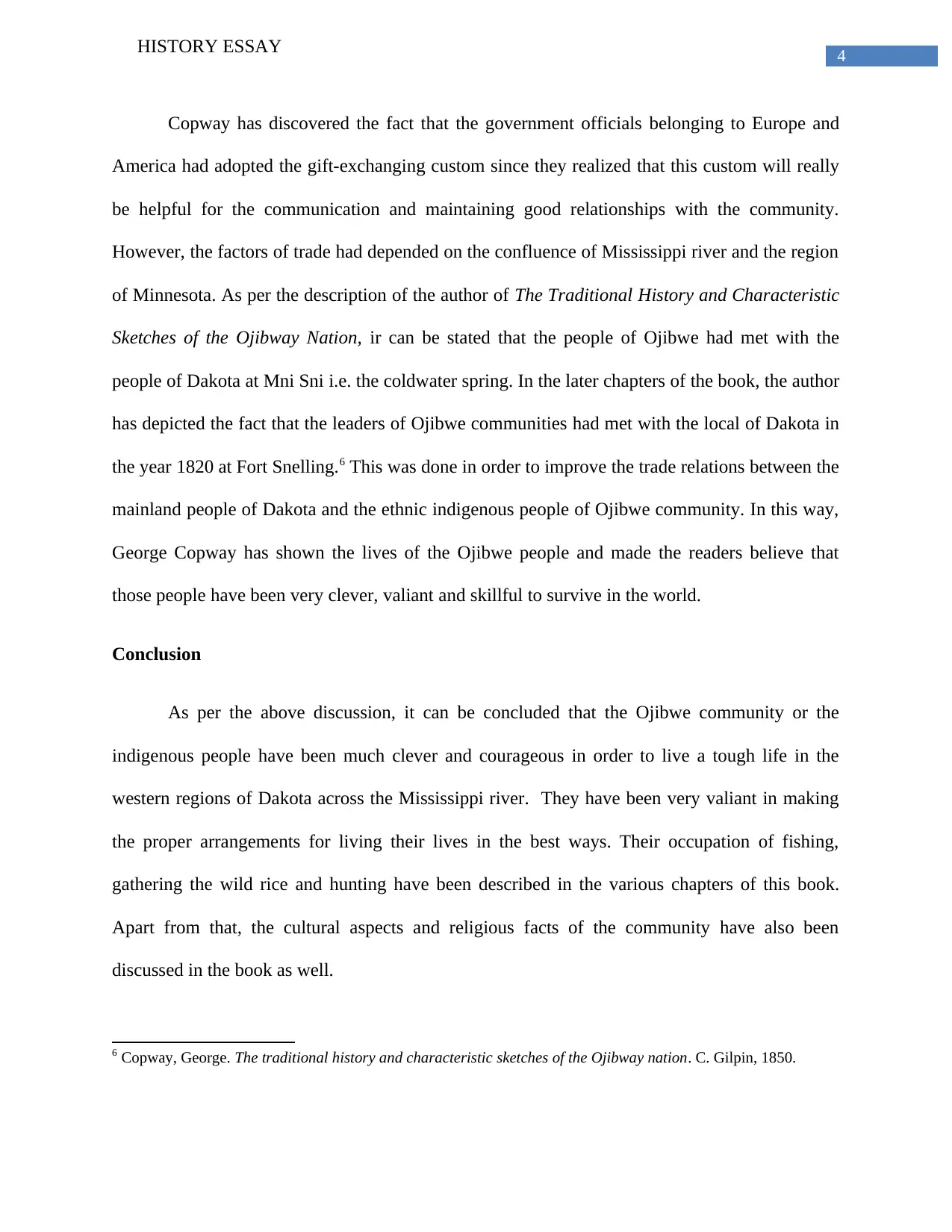
4
HISTORY ESSAY
Copway has discovered the fact that the government officials belonging to Europe and
America had adopted the gift-exchanging custom since they realized that this custom will really
be helpful for the communication and maintaining good relationships with the community.
However, the factors of trade had depended on the confluence of Mississippi river and the region
of Minnesota. As per the description of the author of The Traditional History and Characteristic
Sketches of the Ojibway Nation, ir can be stated that the people of Ojibwe had met with the
people of Dakota at Mni Sni i.e. the coldwater spring. In the later chapters of the book, the author
has depicted the fact that the leaders of Ojibwe communities had met with the local of Dakota in
the year 1820 at Fort Snelling.6 This was done in order to improve the trade relations between the
mainland people of Dakota and the ethnic indigenous people of Ojibwe community. In this way,
George Copway has shown the lives of the Ojibwe people and made the readers believe that
those people have been very clever, valiant and skillful to survive in the world.
Conclusion
As per the above discussion, it can be concluded that the Ojibwe community or the
indigenous people have been much clever and courageous in order to live a tough life in the
western regions of Dakota across the Mississippi river. They have been very valiant in making
the proper arrangements for living their lives in the best ways. Their occupation of fishing,
gathering the wild rice and hunting have been described in the various chapters of this book.
Apart from that, the cultural aspects and religious facts of the community have also been
discussed in the book as well.
6 Copway, George. The traditional history and characteristic sketches of the Ojibway nation. C. Gilpin, 1850.
HISTORY ESSAY
Copway has discovered the fact that the government officials belonging to Europe and
America had adopted the gift-exchanging custom since they realized that this custom will really
be helpful for the communication and maintaining good relationships with the community.
However, the factors of trade had depended on the confluence of Mississippi river and the region
of Minnesota. As per the description of the author of The Traditional History and Characteristic
Sketches of the Ojibway Nation, ir can be stated that the people of Ojibwe had met with the
people of Dakota at Mni Sni i.e. the coldwater spring. In the later chapters of the book, the author
has depicted the fact that the leaders of Ojibwe communities had met with the local of Dakota in
the year 1820 at Fort Snelling.6 This was done in order to improve the trade relations between the
mainland people of Dakota and the ethnic indigenous people of Ojibwe community. In this way,
George Copway has shown the lives of the Ojibwe people and made the readers believe that
those people have been very clever, valiant and skillful to survive in the world.
Conclusion
As per the above discussion, it can be concluded that the Ojibwe community or the
indigenous people have been much clever and courageous in order to live a tough life in the
western regions of Dakota across the Mississippi river. They have been very valiant in making
the proper arrangements for living their lives in the best ways. Their occupation of fishing,
gathering the wild rice and hunting have been described in the various chapters of this book.
Apart from that, the cultural aspects and religious facts of the community have also been
discussed in the book as well.
6 Copway, George. The traditional history and characteristic sketches of the Ojibway nation. C. Gilpin, 1850.

5
HISTORY ESSAY
References
Copway, George. The traditional history and characteristic sketches of the Ojibway nation. C.
Gilpin, 1850.
HISTORY ESSAY
References
Copway, George. The traditional history and characteristic sketches of the Ojibway nation. C.
Gilpin, 1850.
1 out of 6
Your All-in-One AI-Powered Toolkit for Academic Success.
+13062052269
info@desklib.com
Available 24*7 on WhatsApp / Email
![[object Object]](/_next/static/media/star-bottom.7253800d.svg)
Unlock your academic potential
© 2024 | Zucol Services PVT LTD | All rights reserved.